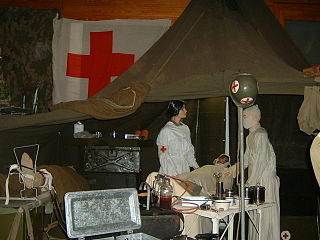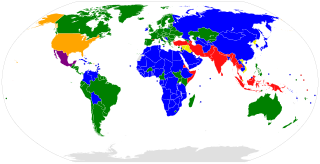
A war crime is an act that constitutes a serious violation of the laws of war that gives rise to individual criminal responsibility. Examples of war crimes include intentionally killing civilians or prisoners, torturing, destroying civilian property, taking hostages, performing a perfidy, raping, using child soldiers, pillaging, declaring that no quarter will be given, and seriously violating the principles of distinction and proportionality, such as strategic bombing of civilian populations.

Civilian casualties occurs in a general sense, when civilians are killed or injured by non-civilians, mostly law enforcement officers, military personnel, or criminals such as terrorists and bank robbers. Under the law of war, it is referred to civilians who perished or suffered wounds as a result of wartime acts. In both cases, they can be associated with the outcome of any form of action regardless of whether civilians were targeted directly or not.
In general, a civilian is "a person who is not a member of the military or of a police or firefighting force". The definition distinguishes from persons whose duties involves risking their lives to protect the public at large from hazardous situations such as terrorism, riots, conflagrations, or wars. It also does not include "criminals" in the category, as authorities and the media wants to distinguish between those who are law-abiding and those who are not.

An unlawful combatant, illegal combatant or unprivileged combatant/belligerent is a person who directly engages in armed conflict in violation of the laws of war or is fighting outside of internationally recognized military forces. An unlawful combatant may be detained or prosecuted under the domestic law of the detaining state for such action, subject to international treaties on justice and human rights.

The law of war refers to the component of international law that regulates the conditions for war and the conduct of warring parties. Laws of war define sovereignty and nationhood, states and territories, occupation, and other critical terms of international law.
Combatant is the legal status of an individual who has the right to engage in hostilities during an international armed conflict. The legal definition of "combatant" is found at article 43 of Additional Protocol One to the Geneva Conventions of 1949 [AP1]. It states that "Members of the armed forces of a Party to a conflict are combatants, that is to say, they have the right to participate directly in hostilities."
Non-combatant is a term of art in the law of war and international humanitarian law, describing civilians who are not taking a direct part in hostilities; persons—such as combat medics and military chaplains—who are members of the belligerent armed forces but are protected because of their specific duties ; combatants who are placed hors de combat; and neutral persons not involved in fighting for one of the belligerents involved in a war. This particular status was first recognized under the Geneva Conventions with the First Geneva Convention of 1864.
International humanitarian law (IHL) is the law that regulates the conduct of war. It is that branch of international law which seeks to limit the effects of armed conflict by protecting persons who are not participating in hostilities, and by restricting and regulating the means and methods of warfare available to combatants.

A summary execution is an execution in which a person is accused of a crime and immediately killed without benefit of a full and fair trial. Executions as the result of summary justice are sometimes included, but the term generally refers to capture, accusation, and execution all conducted simultaneously or within a very short period of time, and without any trial at all. Under international law, refusal to accept lawful surrender in combat and instead killing the person surrendering is also categorized as a summary execution.
An enemy combatant is a person who, either lawfully or unlawfully, directly engages in hostilities for an enemy state or non-state actor in an armed conflict. Prior to 2008, the definition was: "Any person in an armed conflict who could be properly detained under the laws and customs of war." In the case of a civil war or an insurrection the term "enemy state" may be replaced by the more general term "Party to the conflict".

Protocol II is a 1977 amendment protocol to the Geneva Conventions relating to the protection of victims of non-international armed conflicts. It defines certain international laws that strive to provide better protection for victims of internal armed conflicts that take place within the borders of a single country. The scope of these laws is more limited than those of the rest of the Geneva Conventions out of respect for sovereign rights and duties of national governments.
Competent Tribunal is a term used in Article 5 paragraph 2 of the Third Geneva Convention, which states:
Should any doubt arise as to whether persons, having committed a belligerent act and having fallen into the hands of the enemy, belong to any of the categories enumerated in Article 4, such persons shall enjoy the protection of the present Convention until such time as their status has been determined by a competent tribunal.

Detention is the process whereby a state or private citizen lawfully holds a person by removing his or her freedom or liberty at that time. This can be due to (pending) criminal charges preferred against the individual pursuant to a prosecution or to protect a person or property. Being detained does not always result in being taken to a particular area, either for interrogation or as punishment for a crime.
Military Police: Enemy Prisoners of War, Retained Personnel, Civilian Internees and Other Detainees is the full title of a United States Army regulation usually referred to as AR 190-8, that lays out how the United States Army should treat captives.
The United Nations Mercenary Convention, officially the International Convention against the Recruitment, Use, Financing and Training of Mercenaries, is a 2001 United Nations treaty that prohibits the recruitment, training, use, and financing of mercenaries. At the 72nd plenary meeting on 4 December 1989, the United Nations General Assembly concluded the convention as its resolution 44/34. The convention entered into force on 20 October 2001 and has been ratified by 35 states.

Protected persons is a legal term under international humanitarian law and refers to persons who are under specific protection of the 1949 Geneva Conventions, their 1977 Additional Protocols, and customary international humanitarian law during an armed conflict.










